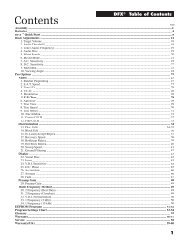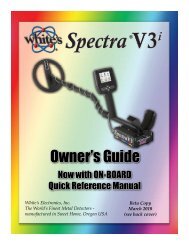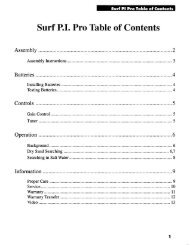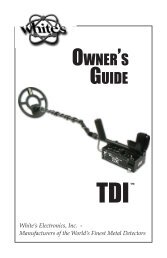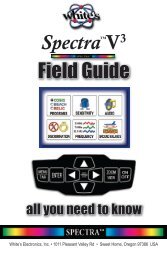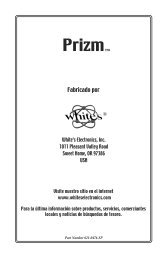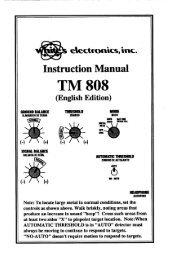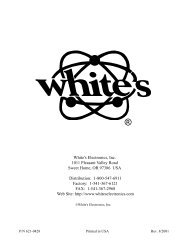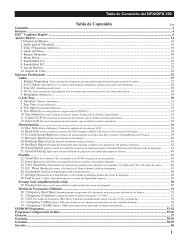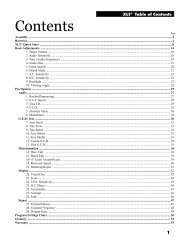Owners Guide - White's Metal Detectors
Owners Guide - White's Metal Detectors
Owners Guide - White's Metal Detectors
Create successful ePaper yourself
Turn your PDF publications into a flip-book with our unique Google optimized e-Paper software.
®<br />
Complete Owner’s <strong>Guide</strong> - Spectra 9<br />
The current target VDI number appears much larger above the rectangle upper left side of display. Listen for a<br />
solid repeatable (over multiple search coil passes) audio “beep” then look for a consistent Icon and/or VDI number<br />
indicating a good quality metal target.<br />
• While sweeping the search coil metal targets will produce blocks above the -95-0-+95 metal range for<br />
each frequency currently in use. Their position in relation to the -95-0-+95 range will indicate the electrical characteristics<br />
(target signature) of the metal itself, which is based on the exact metal alloy and size.<br />
In the COIN Program rejected VDI range blocks appear in RED, Accept VDI range blocks appear in Green.<br />
Taller and narrower block patterns indicate higher quality metal alloys. Top block (always the highest frequency) represents<br />
22.5 kHz, center blocks 7.5 kHz, and bottom blocks (always the lowest frequency) 2.5 kHz. Typically gold<br />
and nickel respond better / stronger at 22.5 kHz, brass better / stronger at 7.5, and silver/copper better / stronger at<br />
2.5 kHz. Noting which line of blocks fades last (lingers longest) is a further indication of the targets likely alloy.<br />
Multiple targets near each other can be tricky. When unusual variations are noticed, sweep the area from<br />
several different directions and/or hold the toggle on the grip and “X” the area to check for multiple targets. Then<br />
sweep each separately and note audio and display.<br />
ICONs - In combination with the VDI number and target signature blocks, an ICON will appear above the<br />
rectangle in the upper right side of display, and a large VDI (visual discrimination indication or reference number)<br />
that represents that range will appear on the upper left side of the display. Some variation is expected from one<br />
search coil sweep to the next. However, overall consistency over several sweeps will produce an accurate indication<br />
of the metal alloy. Multiple targets near each other can be tricky. When unusual variations are noticed, sweep<br />
the area from several different directions, hold the toggle, to check for multiple targets.<br />
• Sweep the search coil close to the ground, scrubbing in grass, an inch above rocky, sandy, or coarse<br />
grounds, from side to side, overlapping each pass by 50%. Avoid arching at the end of each sweep, maintain about<br />
two seconds per pass from left to right and about two seconds returning from right to left. The search coil must<br />
remain in motion for metals to respond.<br />
• Ignore the display and listen for a solid sounding, repeatable audio “BEEP” upon several passes of the<br />
search coil. Ignore inconsistent, or broken sounds. Solid, repeatable “BEEPs”, after multiple passes indicate a<br />
metal target of interest.<br />
• Then look at display. Once a solid and repeatable “BEEP” has been located, sweep over it several times,<br />
and look at the display. A narrow tall bar graph in a desired range plus the large VDI number in the upper left side<br />
of display, and a desired target ICON will indicate a good metal target worth digging.



